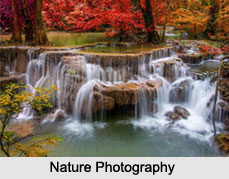 The wildlife sanctuaries and national parks in India provide one ample opportunity to enjoy photography tours in India. Whether north, south, east, west or central India; the country has plenty of national parks and sanctuaries to boast of. The famous wildlife sanctuaries are Bandhavgarh, Kaziranga, Kanha, Shivpuri, Periyar, Gir, Ranthambore, Bharatpur and Corbett. Most of them are tiger reserves, which are home to the famous Indian royal Bengal Tiger/ White Tigers. A photograph of a roaring Lion, yawning tiger, an alert leopard, a jolly elephant or huge flying pelicans - one can click the snap of every rare moment forever, giving one the satisfaction and thrill of wildlife photography.
The wildlife sanctuaries and national parks in India provide one ample opportunity to enjoy photography tours in India. Whether north, south, east, west or central India; the country has plenty of national parks and sanctuaries to boast of. The famous wildlife sanctuaries are Bandhavgarh, Kaziranga, Kanha, Shivpuri, Periyar, Gir, Ranthambore, Bharatpur and Corbett. Most of them are tiger reserves, which are home to the famous Indian royal Bengal Tiger/ White Tigers. A photograph of a roaring Lion, yawning tiger, an alert leopard, a jolly elephant or huge flying pelicans - one can click the snap of every rare moment forever, giving one the satisfaction and thrill of wildlife photography.
Photographing wildlife in their natural habitat provides an exciting insight into their fascinating and complicated world. It is bewitching and equally exciting to photograph a breath taking sunset or capture a colourful avian in flight. But photographing wildlife is no easy job. It is absolutely different from clicking a photo of a human being in cities. The subject, which is often difficult to spot, may also be perilous at times. A wildlife photographer must have a sharp vision, loads of patience, courage and quick reflexes. Too often photographers forget about one of the most important criteria of wildlife and nature photography - Preparation. Not only one must have a complete understanding of camera equipment, but also have a thorough understanding of the natural environment. And India, with its astonishing variety of flora and fauna, many of which are yet unknown to humanity, need even more attention and care to be identified and then photographed. The country`s flora comprises 15000 flowering plants that are 6% of the world`s total. India`s faunal diversity is also high, with its 1178 bird species representing 14% of the world`s total. Similarly there are over 500 species of mammals, 30,000 insects and over 400 varieties of reptiles. In short this sub-continent is a paradise for those who love to observe the grace and beauty of the flora and fauna and for those who want to capture it on film.
Due to India being a host to an assortment of jungles in different atmospheric and weather conditions, it is necessary for any photographer to accept the challenges with élan and discipline. The primary aspect would be to know one`s subject of photography and the object he/she wants to shoot. Otherwise, there is a chance of getting lost amidst the hugeness, and for this it is necessary to be aware of the animals` habitat and habits. Secondly, one should always dress appropriately for the occasion. The costume should never be too flashy; it is best to avoid strong smelling perfumes to gain unwanted attention. Then again, most national parks in India will require one to be accompanied by a guide. This will help the photographer to be able to gather valuable information and avoid missing on a priceless shot. Lastly, poaching is one huge and crucial problem in the Indian forestry. Thus, by protecting oneself from the adversities, it is also mandatory to respect Mother Nature and in the process not to ever harm the priceless wildlife and destroy them.














